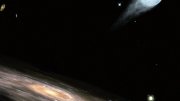The center of the Milky Way galaxy is a crowded, busy neighborhood: clusters upon clusters of pulsating young stars, giant clouds of gas, dying stars exploding, and, in the middle of it all, a massive black hole. So powerful is the gravitational pull of the black hole that stars in closest orbit have been measured circling it at 26.8 million miles per hour--far faster than the sun, which pokes around the galaxy at a mere 500,000 miles per hour.
According to Warren Brown, an astronomer at the Harvard-Smithsonian Center for Astrophysics, this black hole has an effect that extends beyond its close neighbors. In rare cases, certain star clusters have come too close to the black hole and been slung free on a trajectory that sends one of the stars hurtling out of the galaxy--leaving in its wake clues about both the history and the structure of the universe.
Brown discovered the first of these “hypervelocity” stars in 2005 by sheer serendipity. After finishing his Ph.D. in astronomy at Harvard in 2002, he set out to study the movement of older blue stars on the fringes of the Milky Way. (Their increased end-of-life luminosity and puffed size makes them stand out more clearly.) In the midst of his surveys, he discovered a much younger blue star inexplicably speeding toward the edge of the galaxy--on an escape trajectory--at 1.6 million miles per hour. “It was an outlier,” says Brown. “It was so fast that you couldn’t explain it with normal mechanisms.”
He theorized that the star, to generate so much speed, must initially have been part of a trio: a close pair of stars and a third that orbited the two. “We think this third, outer, star was sort of trapped into an orbit around the black hole because it was farther out,” says Brown. As the third star was pulled off, the remaining pair gained gravitational energy from the black hole and were propelled away at an accelerated speed, eventually merging into one.
His most recent paper on the subject, published in July by Astrophysical Journal Letters, confirms what Brown had long suspected: that the resulting star’s origin was the center of the Milky Way. Using NASA’s Hubble Space Telescope, he and a team of researchers pinpointed the exact location of the star in July 2006, and again last December. The difference between the two images was nothing more than a fraction of a pixel, but it was enough to indicate where the star’s path began. “It was pretty exciting,” says Brown. “The proper motion pointed directly back to the center of the Milky Way galaxy.” The discovery challenged previous suggestions from other astronomers that hypervelocity stars could have come from outside the galaxy--specifically from a nearby satellite galaxy known as the Large Magellanic Cloud.
Brown has now identified 13 more of the 16 known hypervelocity stars, and intends to locate more of these rare celestial bodies, which account for just one in every 100 million stars. All his previous surveys of the sky have focused on the Northern Hemisphere, but he plans to begin working with a team of astronomers at Australian National University to examine the southern sky. “I think there’s every reason to expect we’ll have a sample of 40 to 50 stars in five years,” he says.
Building a cache of data from the stars will help Brown and other astronomers begin to answer larger questions about the universe. “Hypervelocity stars can provide a measure of what’s been happening down in the galactic center in the past few hundred million years,” he says.
They could also offer a better understanding of dark matter--the mysterious, unseen substance throughout the universe that has long been one of astronomy’s greatest mysteries. As the stars continue their galactic exit, Brown will be watching for any deviation in their trajectories caused by gravitational influences. “How they arc out betrays the distribution of mass in the Milky Way--both the stars we can see and the dark matter that we can’t see,” he explains. “So we may actually have our first measure of the distribution of dark matter around the Milky Way.”








